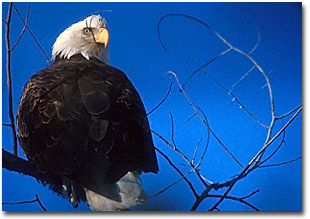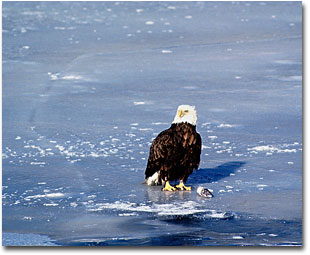Those who want to photograph bald eagles in the wild need to do so with extreme caution. The bald eagle is presently a threatened species under the Federal Endangered Species Act in the lower 48 United States. This bird is also protected by other federal and state laws that carry severe penalties for anyone who harasses one, including approaching one too closely. While its ESA status is expected to change soon, with a delisting to occur perhaps even in 2001, these birds will still enjoy protection under these other laws.
But legitimate nature photographers don't need laws to make them treat wildlife with respect. Or do they? Hopefully none who read this column do. But some of the restrictions of these laws might surprise even those concerned with the well being of their subjects. I believe that we nature photographers should be as aware as possible of natural history and biological concerns for the wild animals that we hope to capture on film. In the case of a protected species, those concerns include the details of the law.
How much do you know about the life cycle of the bald eagle? Of its amazing recovery in the last 30 years, thanks to the dedication of a bunch of caring people - and the legal protection of the Endangered Species Act?
While you don't need to know the answers to these to photograph a bald eagle, those who do will have more and better photo opportunities without interfering in the lives of their subjects.
When I first wanted to photograph bald eagles up close and personal a dozen years ago, I started by looking around in my home state of Maine. My First Rule of Wildlife Photography states that no telephoto lens exists that can offset a lack of technique in getting close to the critters. But, you see, it's against the law to approach close enough to most bald eagle nests for photographs you'd be happy with, even with the 700mm of firepower I can muster. Rare exceptions occur where eagles have decided to nest near roadways in some specific locations. I hoped to find a nest that I could get close enough to without causing the eagles any harm. But in Maine, the closest distance one can get to any nest tree even today remains about 300 feet.
Since nest sites were out, I decided to look for feeding eagles. Reading told me that Maine's bald eagles feed more than 50% off of fish. That gave me lots of territory to cover - too much for productive camera hunting.

Since over winter bald eagles need open water to catch fish, I figured that the best time to camera hunt for close-ups of this species might be during the cold of the Maine winter. With less places to fish, the birds would be concentrated, and that would tip the odds to my advantage. I learned that some of the best places to look for eagles were downstream from dams that keep water open for limited stretches. Dams also chew up a few fish to make easy pickings for the birds. I sought and found such a place not far from Bangor, just below the Veazie dam. I obtained permission to set up a blind - essential for not scaring off the birds.
Once I had my spot, it still wasn't so easy. Remember that it's vital not to harass these birds. During the winter, wildlife needs to maintain energy reserves for survival. Wasted effort fleeing enough human encounters can mean death for a bald eagle. I had to be in the blind before dawn when the eagles came down river to perch in tall white pines across the way. Then I had to wait until they moved on, sometimes watching them for hours without one ever coming close enough to fire a single frame of photography.
Anyone pursuing wildlife photography in winter really needs to understand the survival needs of their subjects. They should also know something about cameras when it's REALLY COLD. A Nicad battery in the camera or a separate battery pack or spares in a warm pocket are essential to keep a modern camera operating when it's below zero. Film should be rewound slowly, preferably by hand, to prevent tearing the brittle stuff or the possibility that static electric sparks will imprint on the film. It's also vitally important not to breathe into the camera when you change film or lenses. Note - Never bring a frozen camera directly into a warm place. While one trick is to seal the camera in a plastic bag that will keep damaging condensation moisture on the outside of the bag, I prefer to also warm my cameras very gradually after such a day.
So there I was, waiting in a makeshift blind during the pre-dawn hours wondering in the minus 20 degree cold why I was doing it. I still had to have an eagle come close enough to get the shot that I wanted. To do that, I had to find a way to sit still for hours in all of that cold. How long can you sit in 20 below zero without moving?
Over the years, I've learned the advantages of dressing in layers: layers and layers of synthetic long underwear, wool and windbreakers; heavy wool mittens over wool fingertip-less gloves over thinner synthetic gloves, with chemical hand warmers as a backup; layers of socks in large enough insulated boots with chemical foot warmers. The foot problem was the worst: because I sat on a stool, the rest of me was not in ground contact. And that ground was cold! A thick carpet remnant on the frozen ground works wonders. I also learned to forego coffee in the morning. A thermos of hot chocolate was much better. High-energy food snacks, such as chocolate, peanuts and raisins, helped keep my metabolism going. And a bodily function relief jug was essential.

My reward came when after days of planning and waiting and hoping, this bird flew over and sat in the right place for all of fifteen seconds. Because I expected it and knew how to use my equipment, but mostly because I was able to stand all of that cold, I got the image that I wanted - my first eagle portrait.
Since then, I've learned a lot more about bald eagles and where and how to photograph them, enough to amass a file of over 10,000 images of these wondrous birds for my book Just Eagles with author Alan Hutchinson.
Catch yours in the good light.
BS-NPN
Answers To Camera Hunter Quiz
- About 20% of the nesting bald eagles in the lower 48 do so in Florida
- Nearly 6,000 pairs nest in the lower 48 states today, up from the 417 pairs left by the 1970's, when DDT was banned and ESA protection was provided.
- The most sensitive time at the nest is when the birds are either sitting on eggs or tending a recent hatchling. Any interference that drives the adult away, even for a few minutes, can cause disaster.
- Eaglets hatch out after 35 days or so of incubation.
- Eaglets fledge after about 12 weeks.
- It is against the law to take any eagle feather, no matter how you found it. Special provisions for Native American religious needs are met through a Federal Repository of salvaged birds that died in accidents.
Maine wildlife & nature photographer Bill Silliker, Jr. – The Mooseman - photographed at many wild places in North America, with the results published in magazines internationally and in 9 of his own books. Bill was an instructor of wildlife and nature photography for L. L. Bean's Outdoor Discovery Program and a member of the Fuji Film Talent Team. Read more about Bill on the Camera Hunter archives page.



